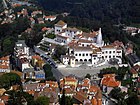
A hotel is an establishment that provides paid lodging on a short-term basis. Facilities provided inside a hotel room may range from a modest-quality mattress in a small room to large suites with bigger, higher-quality beds, a dresser, a refrigerator, and other kitchen facilities, upholstered chairs, a television, and en-suite bathrooms. Small, lower-priced hotels may offer only the most basic guest services and facilities. Larger, higher-priced hotels may provide additional guest facilities such as a swimming pool, a business center with computers, printers, and other office equipment, childcare, conference and event facilities, tennis or basketball courts, gymnasium, restaurants, day spa, and social function services. Hotel rooms are usually numbered to allow guests to identify their room. Some boutique, high-end hotels have custom decorated rooms. Some hotels offer meals as part of a room and board arrangement. In Japan, capsule hotels provide a tiny room suitable only for sleeping and shared bathroom facilities.

Sintra is a town and municipality in the Greater Lisbon region of Portugal, located on the Portuguese Riviera. The population of the municipality in 2021 was 385,654, in an area of 319.23 square kilometres (123.26 sq mi). Sintra is one of the most urbanized and densely populated municipalities of Portugal. A major tourist destination famed for its picturesqueness, the municipality has several historic palaces, castles, scenic beaches, parks and gardens.

Estoril is a town in the civil parish of Cascais e Estoril of the Portuguese Municipality of Cascais, on the Portuguese Riviera. It is a popular tourist destination, with hotels, beaches, and the Casino Estoril. It has been home to numerous royal families and celebrities, and has hosted a number of high-profile events, such as the Estoril Open and the Lisbon & Estoril Film Festival.

José Maria de Eça de Queiroz or Queirós is generally considered to have been the greatest Portuguese writer in the realist style. Zola considered him to be far greater than Flaubert. In the London Observer, Jonathan Keates ranked him alongside Dickens, Balzac and Tolstoy.

Cascais is a town and municipality in the Lisbon District of Portugal, located on the Portuguese Riviera. The municipality has a total of 214,158 inhabitants in an area of 97.40 km2. Cascais is an important tourist destination. Its marina hosts events such as the America's Cup and the town of Estoril, part of the Cascais municipality, hosts conferences such as the Horasis Global Meeting.

Setúbal is a city and a municipality in Portugal. The population of the entire municipality in 2014 was 118,166, occupying an area of 230.33 km2 (88.9 sq mi). The city itself had 89,303 inhabitants in 2001. It lies within the Lisbon metropolitan area, about 50 kilometres from Lisbon downtown by road.

Eugénio de Paula Tavares was a Cape Verdean poet. He is known through his famous poems (mornas), mostly written in the Creole of Brava.

Nova Sintra is a city in the central part of the island of Brava in southwestern Cape Verde. It serves as the seat of the Brava Municipality. The settlement is named after Sintra, the summer residence of the Portuguese kings. Its population is about 1,500. Its elevation is around 500 meters. Since 2010, Nova Sintra has been a city. Agriculture is the predominant source of income on Brava. Tourism is less developed, but there are a few small hotels and guest houses. The "aluguer" buses to the other villages start from Praça Eugénio Tavares.

José Duarte Ramalho Ortigão was a Portuguese writer of the late 19th century and early 20th century.

Tourism in Portugal serves millions of international and domestic tourists. Tourists visit to see cities, historic landmarks, enjoy beaches, or religious sites. As of 2023, Portugal had 26.5 million international visitors. In addition, there were also 11 million trips made by Portuguese residents including overnight stays at local hotels.
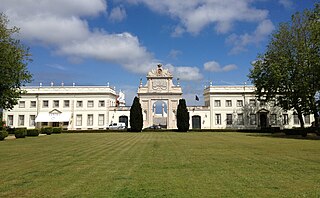
The Seteais Palace is a neoclassical palace located in Sintra, on the Portuguese Riviera, operating as a luxury hotel known as the Tivoli Palácio de Seteais Hotel. The palace is a national landmark and is included in the UNESCO Cultural Landscape of Sintra World Heritage Site listing.
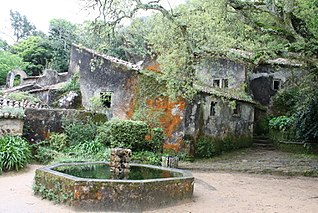
The Convent of the Friars Minor Capuchin, popularly known as the Convent of the Capuchos, but officially the Convento da Santa Cruz da Serra de Sintra, is a historical convent consisting of small quarters and public spaces located in the civil parish of São Pedro de Penaferrim, in Sintra Municipality, Portugal. Its creation was associated with the Portuguese Viceroy of India, D. João de Castro, and his family, but became a pious community of reclusive clergy that continued to occupy cramped humble spaces in the complex until the religious orders were abolished in Portugal.
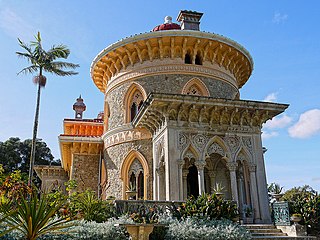
The Portuguese Riviera is a term used in the tourist industry for the affluent coastal region to the west of Lisbon, Portugal, centered on the coastal municipalities of Cascais, Oeiras and Sintra. It is coterminous with the Estoril Coast and occasionally known as the Costa do Sol. Portuguese themselves do not use this expression.

Summer architecture was a Portuguese architectural movement originating in the Portuguese Riviera, in the late 19th and early 20th centuries, when the region became a popular resort destination for the Portuguese royal family and the Portuguese aristocracy. The movement is not characterized by any single architectural style or artistic school, but rather unified by common themes, including leisure, wellness, exoticism, and heterotopia.

Quinta da Beloura is an affluent gated community and golf resort located in Linhó, Sintra, on the Portuguese Riviera. The community is known for hosting numerous golf tournaments, tennis opens, and equestrian & dressage events, as well as for being the home of numerous famous personalities.
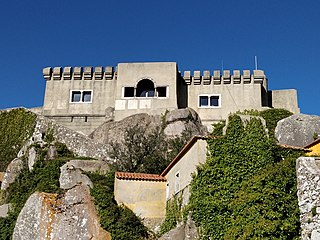
The Sanctuary of Peninha is situated in the Sintra Mountains in the Sintra-Cascais Natural Park, in the Lisbon District of Portugal. It stands at an altitude of 448 metres on top of a rocky outcrop, which provides views over the coastline and inland areas. In addition to a baroque chapel, completed in 1710, the location contains the Palace of Peninha, which dates from 1918, as well as remains of a hermitage. The interiors of neither the chapel nor the palace can presently be visited.

Linhó is an affluent village in the municipality of Sintra, on the Portuguese Riviera, known for its resorts, restaurants, and its two prominent gated communities, Quinta da Penha Longa and Quinta da Beloura. Linhó is home to a large expatriate community, the only American school in Portugal, and has hosted a Bilderberg Meeting.
GuestReady is a property management company and online travel agency headquartered in Trogen, Switzerland. Founded in 2016, it is active in Europe, the Middle East and Southeast Asia. It helps hosts manage their properties on online rental marketplaces such as Airbnb.

Alice Lawrence Oram was a British journalist and translator living in Portugal. As a journalist, she broke the news overseas of the 5 October 1910 revolution that overthrew the Portuguese monarchy.

The Ferreira de Castro Museum is a museum in Sintra, Portugal devoted to the life of José Maria Ferreira de Castro, a Portuguese journalist and writer, who was buried in the hills overlooking the city. The museum is run by the municipality of Sintra and admission is free.




















